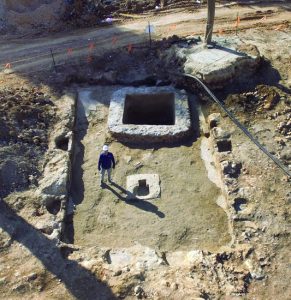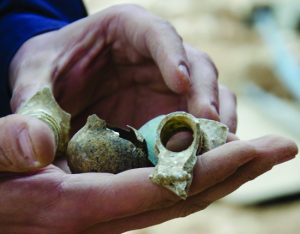×


We have detected your country as:
Please click here to go to the USA website or select another country from the dropdown list.

Aerial view of winery
(Guy Eitoussi/IAA)
Unexpected finds more than 1,600 years old were uncovered during archaeological excavations carried out by the Israel Antiquities Authority (IAA) at the Schneller Compound prior to the construction of new residential buildings.
The Schneller Orphanage operated in Jerusalem from 1860 until the Second World War. During the British Mandate, its German inhabitants were expelled and a military base was established there. After the British withdrawal in 1948 the compound was turned over to the Haganah and later served as an army base used by the Israel Defense Forces until 2008.
A large and impressive winery dating to the Roman or Byzantine period, some 1,600 years ago, was found in the excavations. The complex installation included a pressing surface paved with a white mosaic. In the center was a pit in which a press screw was anchored that aided in extracting the maximum amount of must from the grapes. Eight cells were installed around the pressing surface. These were used for storing the grapes, and possibly also for blending the must with other ingredients thereby producing different flavors of wine. The archaeologists believe that this winery served the residents of a large manor house whose inhabitants made their living primarily by viticulture and wine production.

Numerous pottery sherds and fragments of glassware found inside a plastered pit indicate the possibility that a workshop used the ancient pit for discarding waste.
(IAA)
A bathhouse was unearthed next to the winepress. Terra cotta pipes used to heat the bathhouse and several clay bricks were found, some of which were stamped with the name of the Tenth Roman Legion. The Tenth Legion was one of four Roman legions that participated in the conquest of Jewish Jerusalem, and its units remained garrisoned in the city until c. AD 300. Among the Roman legion’s main centers was the one in the vicinity of the Binyanei HaUma [Jerusalem International Conference Center], located some 800 meters [2,625 ft] from another excavation, where a large pottery and brick production center was situated.
Alex Wiegmann, excavation director on behalf of the IAA said, “Once again, Jerusalem demonstrates that wherever one turns over a stone, ancient artifacts will be found related to the city’s glorious past. The archaeological finds discovered here help paint a living, vibrant and dynamic picture of Jerusalem as it was in ancient times up until the modern era.”
Source: Excerpts from article by Edgar Asher, Ashernet
All logos and trademarks in this site are property of their respective owner. All other materials are property of Bridges for Peace. Copyright © 2025.
Website Site Design by J-Town Internet Services Ltd. - Based in Jerusalem and Serving the World.